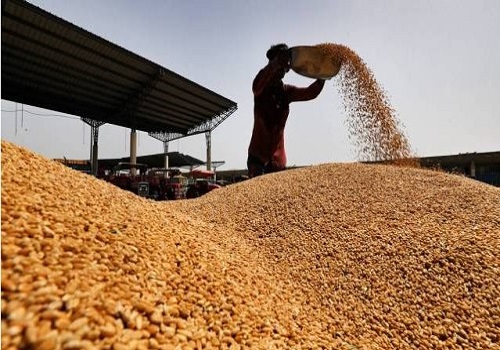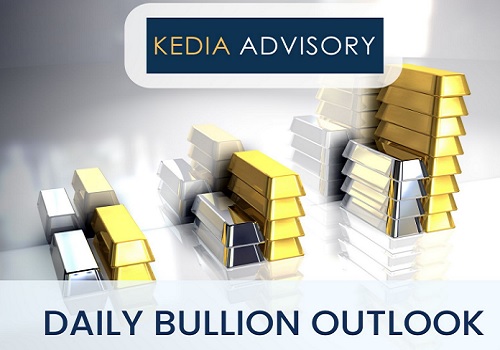Turmeric trading range for the day is 13778-14818 - Kedia Advisory

Gold
Gold prices rose by 0.71% to settle at ?78,710, supported by softer-than-expected core consumer inflation data in the US, which bolstered expectations of a less restrictive monetary policy from the Federal Reserve. Annual core consumer inflation unexpectedly slowed, and headline CPI showed no aggressive upside surprises, reinforcing market sentiment for a possible Fed rate cut as early as July instead of September. This outlook favored non-yielding assets like gold, as the lower opportunity cost strengthened bullion's appeal. Global demand for gold remained robust, with the world's central banks continuing to accumulate reserves. Emerging markets led the trend, as Poland added 21 tonnes in November 2024, bringing its holdings to 448 tonnes, while the Reserve Bank of India added 8 tonnes, bringing total 2024 purchases to 73 tonnes. China's central bank also increased reserves in December for the second consecutive month, reaching 73.29 million fine troy ounces. Meanwhile, gold premiums and discounts varied across key markets. In India, gold discounts rose to $17 per ounce due to higher local prices, discouraging retail demand. Conversely, buying activity increased in other major Asian markets ahead of the Lunar New Year, with modest premiums observed in China, Singapore, and Hong Kong. Gold remains in a fresh buying trend, with open interest rising by 2.31% to 10,324 contracts as prices gained ?554. Immediate support lies at ?78,385, with further downside testing possible at ?78,065. Resistance is seen at ?78,880, and a breakout could push prices toward ?79,055.
Trading Ideas:
* Gold trading range for the day is 78065-79055.
* Gold rose as cooling underlying inflation in the US favored bets of less restrictive monetary policy by the Fed this year.
* The CPI in the US increased 0.4% month-over-month in December 2024, the most since March
* The NY Empire State Manufacturing Index tumbled to -12.6 in January 2025 from 2.1 in December
Silver
Silver prices surged 2.54% to settle at ?92,856, driven by easing inflationary pressures in the US. Softer core inflation in December and no significant upside in headline CPI supported expectations of less restrictive Federal Reserve monetary policy, enhancing the appeal of non-yielding assets like silver. However, silver prices remain below the October peak of $35 per ounce due to uncertainties surrounding industrial demand. China's solar panel sector, a key consumer of silver, faces challenges from overcapacity, prompting photovoltaic companies to adopt supply-regulation measures under a government-backed program. Additionally, allegations of forced labor in Xinjiang-based solar panel plants have led to US import bans, limiting demand prospects further. On the global supply side, the Silver Institute forecasts a 4% reduction in the market deficit to 182 million ounces in 2024, with total supply growing by 2% against a 1% rise in demand. Record industrial demand and recovering jewelry consumption are expected to push silver demand to 1.21 billion ounces in 2024, despite a notable 16% decline in physical investment. Mine production is set to increase by 1% due to higher output in Mexico, Chile, and the US, while recycling is projected to grow by 5%, driven by increased silverware scrap in Western markets. Silver witnessed short covering, with open interest declining by 3.97% to 21,024 contracts as prices rose ?2,300. Immediate support lies at ?91,260, with further downside testing possible at ?89,660. Resistance is at ?93,710, and a breakout could push prices toward ?94,560.
Trading Ideas:
* Silver trading range for the day is 89660-94560.
* Silver rose as softer underlying inflation in the US supported bets of less restrictive monetary policy by the Fed.
* Core inflation unexpectedly slowed in December, while headline inflation refrained from surprising on the upside.
* Still, uncertain demand for silver’s manufacturing usage kept prices well below the 12-year high of $35 from October.
Crude oil
Crude oil prices gained 2.42% to settle at ?6,899, driven by concerns over potential supply disruptions from U.S. sanctions on Russian energy companies and tankers. The International Energy Agency (IEA) warned that the new sanctions could significantly impact Russian oil supply chains, tightening the global oil market. However, the IEA's latest report anticipates a market surplus in 2024, as supply growth, led by non-OPEC+ producers, is expected to outpace the subdued rise in global demand. OPEC reduced its 2024 demand growth projection for the sixth consecutive time, citing weaker consumption from China. Despite this, OPEC maintains a robust demand outlook, forecasting growth of 1.45 million barrels per day (bpd) in 2024 and 1.43 million bpd in 2026. Meanwhile, the U.S. Energy Information Administration (EIA) reported an eighth consecutive weekly decline in crude oil inventories, with a draw of 1.961 million barrels, surpassing expectations. However, gasoline and distillate inventories rose significantly, reflecting increased production activity. The EIA raised its forecast for U.S. oil production in 2024 to 13.55 million bpd, with the Permian Basin accounting for over half of the output by 2026. Global oil production is projected to reach 104.4 million bpd in 2025, slightly above earlier estimates, as OPEC+ eases supply cuts and non-OPEC producers ramp up output. Crude oil prices are under short covering, with a 3.92% drop in open interest to 11,286 contracts. Support is at ?6,747, with further downside possible at ?6,596. Resistance is at ?6,982, and a move above this level could test ?7,066.
Trading Ideas:
* Crudeoil trading range for the day is 6596-7066.
* Crude oil prices rose as the market focused on potential supply disruptions from U.S. sanctions on Russian oil
* IEA says new US sanctions could significantly disrupt Russian supply
* OPEC reduced its figure for 2024 demand growth for a sixth time, highlighting China's sputtering role in driving consumption.
Natural gas
Natural gas prices rose slightly by 0.11% to settle at ?348.7 as forecasts for colder-than-expected weather over the Martin Luther King Jr. holiday weekend pointed to increased heating demand. Meteorologists predict colder-than-normal temperatures across the Lower 48 states through January 25, with the chilliest days anticipated around January 20-21. These conditions could lead to freeze-offs, further reducing production, which already fell to 103.2 billion cubic feet per day (bcfd) in January from December's 104.2 bcfd. Historical data reveals freeze-offs significantly impact production, with notable cuts in past winters. U.S. utilities reported a withdrawal of 40 billion cubic feet from natural gas storage, reducing stockpiles to 3,373 bcf. This marked the eighth consecutive draw, narrowing the surplus over the five-year average to 6.5% and putting inventories 0.1% below last year’s levels. Demand for natural gas, including exports, is forecast to rise to 153.0 bcfd next week, driven by heating needs. LNG exports are projected to reach a record 14.1 bcfd in 2025, rising further to 16.2 bcfd in 2026, signaling robust international demand. Natural gas witnessed fresh buying, with a 0.69% increase in open interest to 12,299 contracts. Immediate support is at ?336.9, with a further downside potentially testing ?325.2. Resistance is seen at ?357.6, and a break above this level could push prices toward ?366.6.
Trading Ideas:
* Naturalgas trading range for the day is 325.2-366.6.
* Natural gas rose on forecasts for more frigid weather over the weekend than previously expected
* Cold to boost gas demand to record highs on Jan 20-21
* Jan 20-21 could be the coldest days since Jan 2024
Copper
Copper prices gained 0.33% to settle at ?832.25, driven by China's commitment to aggressive economic support measures, including fiscal and monetary policies, to stimulate consumption. Chinese customs data revealed an 18% increase in unwrought copper and copper product imports in December, reaching 559,000 metric tons, the highest in 13 months. This uptick reflects higher intake by smelters, signaling a potential rise in manufacturing activity. Furthermore, robust export performance from China, the world's largest manufacturer, added to the positive sentiment. On the supply side, Chile's copper output showed significant gains, with state-run miner Codelco reporting a 16.9% year-on-year production increase in November to 133,600 metric tons. BHP's Escondida mine production surged by 27.6% to 108,200 tons, while output from the Collahuasi mine fell by 23.5% to 36,700 tons. Despite these gains, the global refined copper market recorded a 41,000 metric ton deficit in October, narrowing from a 136,000 metric ton deficit in September. Over the first ten months of the year, the market shifted to a 287,000 metric ton surplus, compared to a 9,000 metric ton surplus during the same period in the previous year. Copper's market witnessed short covering, with a 1.01% decline in open interest to 4,995 contracts as prices rose by ?2.7. Support is at ?826.9, with a downside potential toward ?821.4. Resistance is at ?835.3, and a move above this level could test ?838.2, reflecting cautious optimism amid strong demand signals from China.
Trading Ideas:
* Copper trading range for the day is 821.4-838.2.
* Copper gains as the Chinese government committed to aggressive economic support measures.
* Imports of unwrought copper and copper products to China surged by 18% to 559 thousand tonnes in December, the highest in 13 months.
* Concerns about supply disruptions from aging copper mines also continue to support the metal's price outlook.
Zinc
Zinc prices eased by 0.2% to settle at ?273.1 as China's refined zinc production saw steady growth. In December 2024, production increased by over 10,000 metric tons (mt) month-on-month (MoM), while January 2025 output is projected to grow by an additional 15,000 mt MoM. The increase is attributed to production recovery in smelters across regions like Qinghai, Gansu, and Inner Mongolia, along with new capacities in Shanxi. However, seasonal maintenance and Chinese New Year breaks in regions like Hunan and Guangxi may limit the scale of production gains. Despite these factors, the Chinese government's aggressive economic support measures have bolstered optimism, which helped limit downside pressure on prices. Zinc inventories in Shanghai Futures Exchange warehouses declined by 10.8% from the previous week, suggesting tighter short-term supply. On a global scale, the refined zinc market showed a deficit of 69,100 mt in October, rising from 47,000 mt in September. Still, the cumulative market surplus for the first ten months of 2024 stood at 19,000 mt, a significant decrease from the 356,000 mt surplus during the same period last year. Declines in mine output from Canada, South Africa, and Peru contributed to a 3.8% drop in global zinc production from January to October. Zinc witnessed long liquidation as open interest dropped by 5.17% to 2,276 contracts, with prices falling ?0.55. Support is at ?270, with further testing likely at ?266.9. Resistance is seen at ?274.9, and a move above this could test ?276.7, indicating consolidation amid production and inventory dynamics.
Trading Ideas:
* Zinc trading range for the day is 266.9-276.7.
* Zinc dropped as China's refined zinc production in December increased by over 1% MoM.
* In January 2025, domestic refined zinc production will increase by over 15,000 mt MoM or nearly 3% MoM
* Zinc inventories in warehouses monitored by the Shanghai Futures Exchange down 10.80% from last Friday.
Aluminium
Aluminium prices gained 1.15% to settle at ?249.8, driven by concerns over tightening supplies to the European Union if the bloc proceeds with a ban on Russian aluminium imports as part of its sanctions package against Russia. This geopolitical uncertainty has spurred fears of reduced availability in the market, adding upward pressure on prices. Additional support has come from declining aluminium stocks in LME-registered warehouses, which have fallen by 45% since May 2024, now standing at 619,375 tons. Cancelled warrants, at nearly 60%, suggest that a significant portion of the stock is set to leave LME warehouses in the near future, further tightening supply. This dynamic has resulted in the narrowing of the discount for cash aluminium over the three-month contract to about $13 per ton, compared to over $40 in December 2024. However, the upside for aluminium prices remains limited by growing stockpiles in Japan, which rose by 13.2% in December 2024 to 323,600 metric tons. On the production side, global primary aluminium output continues to rise steadily, with China's production in December growing by 4.13% year-on-year. Despite some smelter cuts in Sichuan and Guangxi, global production is expected to surpass 6 million tons per month by the end of 2024. Aluminium is currently in a short covering phase, with open interest decreasing by 6.17% to 2,541 contracts, while prices have risen by ?2.85. Support is at ?246.6, with a potential test of ?243.3 if prices fall further. Resistance is seen at ?251.6, and a move above this level could test ?253.3, indicating potential price consolidation within these levels.
Trading Ideas:
* Aluminium trading range for the day is 243.3-253.3.
* Aluminium rose due to worries about tightening supplies to EU if the bloc bans imports of the metal from Russia.
* Support also seen on concern over sliding stocks in LME, dropped 45% since May last year.
* However upside seen limited as aluminium stocks at Japanese ports rose, up about 13.2% from the previous month
CottonCandy
CottonCandy prices saw a marginal decline of 0.09%, settling at ?54,650, due to expectations of an increase in global cotton production for the 2024-25 cycle. The global production forecast has been revised up by 1.2 million bales, reaching 117.4 million bales, driven by improved yields in India and Argentina. However, the domestic scenario presents a contrasting situation, particularly in India's northern cotton-producing states—Punjab, Haryana, and Rajasthan. Arrivals of kapas in these regions have plummeted by 43% until November 30, 2024, compared to last year, leading to a raw material shortage for ginners and spinners. Farmers, holding back supplies, are awaiting higher prices, intensifying the supply crunch. The Cotton Association of India (CAI) has kept its cotton consumption estimate for 2024-25 at 313 lakh bales, with pressing estimates pegged at 302.25 lakh bales. The significant rise in imports is notable, with projections reaching 25 lakh bales, up from 15.20 lakh bales in the previous season. By November 30, approximately 9 lakh bales had arrived at Indian ports, and the closing stock for September 30, 2025, is expected to be 26.44 lakh bales, lower than last year's 30.19 lakh bales. The market is experiencing fresh selling, with open interest rising by 0.47% to 426 contracts, and prices seeing a slight dip of ?50. Support is seen at ?54,040, and a breach of this level could see prices testing ?53,420. Resistance is pegged at ?55,640, and a break above this level could push prices towards ?56,620.
Trading Ideas:
* Cottoncandy trading range for the day is 53930-54630.
* Cotton dropped as WASDE report projected higher production and ending stocks for the 2024/25 crop year.
* India's cotton production in 2024/25 is likely to fall by 7.4% from a year ago
* Cotton production is projected to increase in China, Brazil, and Argentina, more than offsetting reductions in the US and Spain – USDA
* In Rajkot, a major spot market, the price ended at 25809.65 Rupees dropped by 0 percent.
Turmeric
Turmeric prices settled down by -2.44% at ?14,168, driven by the ongoing harvesting season in Karnataka and Andhra Pradesh, with harvesting expected to begin in Telangana after Makar Sankranti. While the supply of turmeric is anticipated to increase after the festival, concerns over slow growth of rhizomes and lower yield estimates are limiting the downside potential. Farmers have reported that the yield may fall below expectations, making it crucial to monitor the harvesting progress closely. Despite the expected increase in supply, the situation remains complex due to unfavorable weather conditions, with the impact of El-Nino affecting production in both North and South India. Additionally, the supply in the Erode Warangal line has completely dried up, and while the futures market shows pending delivery of sold goods, there is a scarcity of available stocks. The arrival of new turmeric is not expected before April, and the high prices in international markets, coupled with rising domestic consumption, add further pressure. Turmeric exports have shown a positive trend, with a 6.57% increase from April to October 2024, reaching 108,879.96 tonnes. In Nizamabad, a key spot market, turmeric prices ended at ?14,123.35, down by -0.54%.The market is under fresh selling, as evidenced by a 0.83% increase in open interest, with prices declining by ?354. Support is observed at ?13,974, and a break below this level could see prices testing ?13,778. Resistance is at ?14,494, and a move above this level could push prices toward ?14,818.
Trading Ideas:
* Turmeric trading range for the day is 13778-14818.
* Turmeric dropped as harvesting has commenced in Karnataka and Andhra Pradesh and is expected to commence in Telangana.
* However downside seen limited amid concerns over slow growth of rhizomes and low yield estimates persist.
* With the arrival of new crop likely to increase after Makar Sankranti, supply is expected to increase.
* In Nizamabad, a major spot market, the price ended at 14123.35 Rupees dropped by -0.54 percent.
Jeera
Jeera prices settled down by -0.31% at ?22,625, driven by low demand in the domestic market. The current export business is being met by available stock, and while farmers still have about 20 lakh bags of cumin, only 3-4 lakh bags are expected to be traded by the end of the season. This leaves a carry-forward stock of approximately 16 lakh bags, which could put downward pressure on prices in the short term. India’s cumin seed production for 2023-24 increased to 8.6 lakh tonnes, up from 5.77 lakh tonnes in the previous year, supported by better crop conditions and good sowing. India continues to be the world’s cheapest supplier of cumin, with a price of $3,050 per tonne, compared to $200-$250 higher prices from China. This pricing advantage is expected to drive demand, especially from countries like China. The tensions in the Middle East have further boosted exports from Gujarat, with both domestic and international demand increasing due to the upcoming festive seasons. Jeera exports from April to October 2024 rose by 77.37%, reaching 135,450.64 tonnes, with October exports increasing by 161.04% compared to last year. The market is under fresh selling, as reflected by a 1.28% increase in open interest, while prices fell by ?70. Jeera is getting support at ?22,460, and a break below this level could test ?22,280. Resistance is seen at ?22,760, with a move above this level potentially pushing prices towards ?22,880.
Trading Ideas:
* Jeera trading range for the day is 22280-22880.
* Jeera dropped as demand is low and the current export business is being met from the available stock.
* However downside seen limited amid shortage of stocks is contributing.
* The current season is expected to have similar production levels as last year due to better crop conditions and good sowing.
* In Unjha, a major spot market, the price ended at 23423.1 Rupees dropped by -0.28 percent.
Views express by all participants are for information & academic purpose only. Kindly read disclaimer before referring below views























